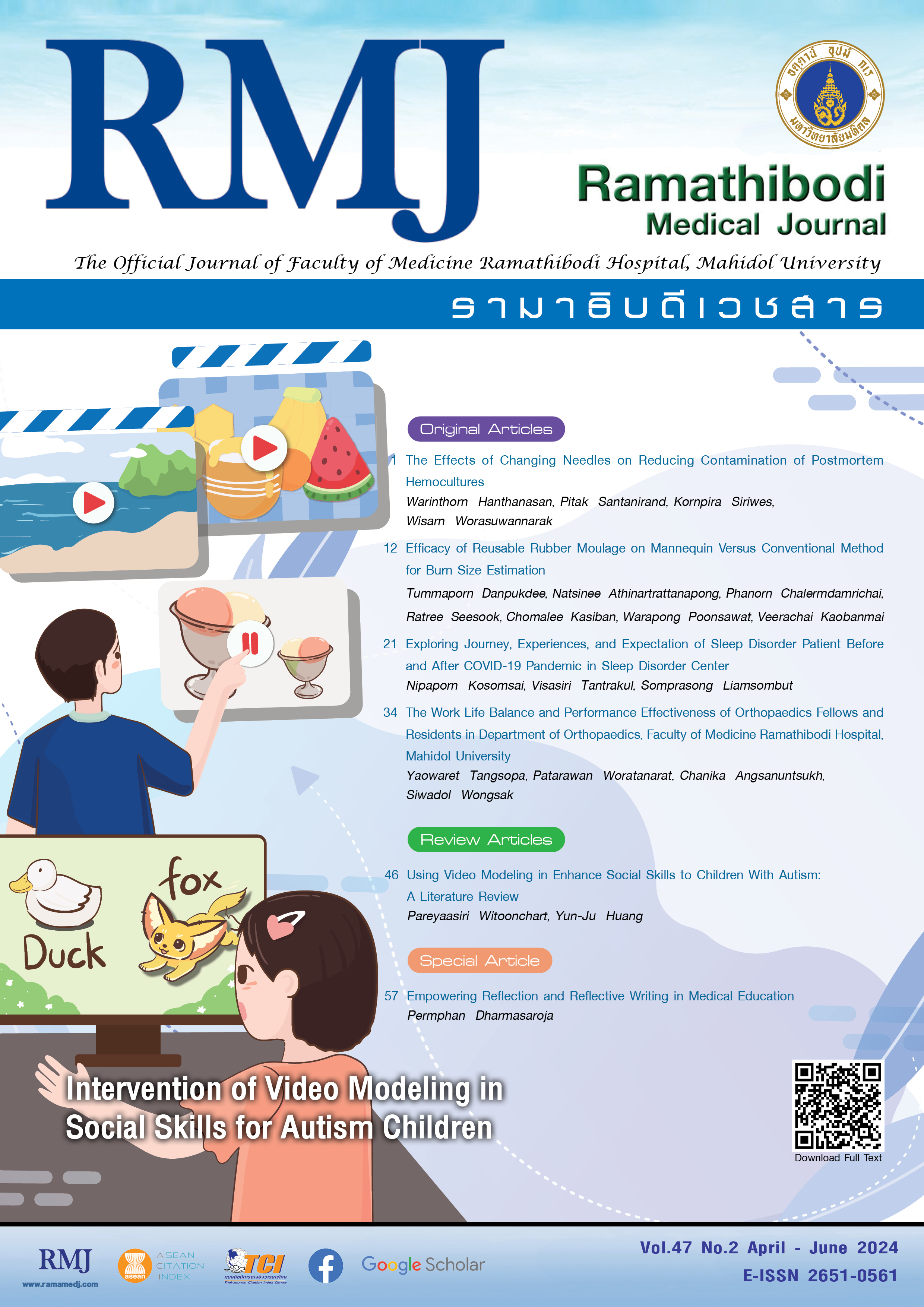The Work Life Balance and Performance Effectiveness of Orthopaedics Fellows and Residents in Department of Orthopaedics, Faculty of Medicine Ramathibodi Hospital, Mahidol University
DOI:
https://doi.org/10.33165/rmj.2024.47.2.267679Keywords:
Economy, Income, Marital status, Personal life, Social lifeAbstract
Background: Fellows and residents in the Department of Orthopaedics have to work throughout the training program. The work life balance and work performance may affect work efficiency.
Objectives: To study and compare work life balance and work performance between fellows and residents in the Department of Orthopaedics, Faculty of Medicine Ramathibodi Hospital, Mahidol University.
Methods: Data collection was using a 54-item that divided into 3 parts. Part 1 collected information about the respondents: gender, marital status, and income level. Part 2 assessed work life balance in 4 dimensions: work, social life, personal life, and economy. Part 3 examined the work performance in terms of efficiency and work behavior. Use analysis of variance to analyze the differences of work life balance between resident and fellow, determine the correlation between work life balance and characteristics of respondents, including the correlation between work life balance and work performance by multiple regression analysis.
Results: The respondents included 10 fellows and 36 residents. Among them, 39 (84.80%) were male, 36 (80.00%) were single, and 33 (71.80%) had an income between ฿20,001 to ฿30,000. Female had significantly higher work life balance in terms of work and economy compared to male. Fellows had significantly higher work life balance in terms of personal life compared to residents (32.80 and 38.60 points respectively, P = .03). Respondents with an income range of ฿30,001 to ฿40,000 had higher work life balance in terms of work and personal life compared to those in other income levels. Respondents who were married had higher work behavior performance compared to those who were single, and the work life balance inversely correlated with income levels.
Conclusions: The study findings can be used to analyze the causes and trends of work performance annually and provide guidance for developing training policies that promote a good work life balance, leading to the highest work performance.
References
Theppawan P. Strategic Human Resource Management: Concepts and Strategies for Competitive Advantage. SE-Education Public Co, Ltd; 2011.
Tatiyapron N, Puwittayatorn T, Suksri NH. The relationships between the work life balance and the work performance efficiency of staffs in Suratthani Hospital. Phuket Rajabhat University Academic Journal. 2016;12(1):21-43.
Fiedler F. A Theory of Leadership Effectiveness. Mc Graw-Hill; 1976.
Hyman J, Summers J. Lacking balance? Work-life employment practices in the modern economy. Pers Rev. 2004;33(4):418-429. doi:10.1108/00483480410539498
Sargent MC, Sotile W, Sotile MO, Rubash H, Barrack RL. Quality of life during orthopaedic training and academic practice. Part 1: orthopaedic surgery residents and faculty. J Bone Joint Surg Am. 2009;91(10):2395-2405. doi:10.2106/JBJS.H.00665
Ames SE, Cowan JB, Kenter K, Emery S, Halsey D. Burnout in orthopaedic surgeons: a challenge for leaders, learners, and colleagues: AOA critical issues. J Bone Joint Surg Am. 2017;99(14):e78. doi:10.2106/JBJS.16.01215
Oskrochi Y, Maruthappu M, Henriksson M, Davies AH, Shalhoub J. Beyond the body: a systematic review of the nonphysical effects of a surgical career. Surgery. 2016;159(2):650-664. doi:10.1016/j.surg.2015.08.017
L Ho SW, K Kwek EB. Levels of burnout and its association with resilience and coping mechanisms among orthopaedic surgery residents: a single institution experience from Singapore. Singapore Med J. 2022;63(7):381-387. doi:10.11622/smedj.2021010
Somkhuan P. The Work Life Balance and Performance Effectiveness General Staff Division Officer in Immigration Bureau. Dissertation. Krirk University; 2014.
Somerson JS, Patton A, Ahmed AA, Ramey S, Holliday EB. Burnout among United States orthopaedic surgery residents. J Surg Educ. 2020;77(4):961-968. doi:10.1016/j.jsurg.2020.02.019
Carr PL, Friedman RH, Moskowitz MA, Kazis LE. Comparing the status of women and men in academic medicine. Ann Intern Med. 1993;119(9):908-913. doi:10.7326/0003-4819-119-9-199311010-00008
Li Y, Cao L, Mo C, Tan D, Mai T, Zhang Z. Prevalence of burnout in medical students in China: a meta-analysis of observational studies. Medicine (Baltimore). 2021;100(26):e26329. doi:10.1097/MD.0000000000026329
Downloads
Published
How to Cite
Issue
Section
License
Copyright (c) 2024 By the Authors. Licensee RMJ, Faculty of Medicine Ramathibodi Hospital, Mahidol University, Bangkok, Thailand

This work is licensed under a Creative Commons Attribution-NonCommercial-NoDerivatives 4.0 International License.

















